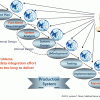Business Transformation Requires Transformational Leaders
Leadership and teaming skills are front and center in times of rapid change. Meet today’s constant disruption head on with expert guidance in leadership, business strategy, transformation, and innovation. Whether the disruption du jour is a digitally-driven upending of traditional business models, the pandemic-driven end to business as usual, or the change-driven challenge of staffing that meets your transformation plans—you’ll be prepared with cutting edge techniques and expert knowledge that enable strategic leadership.
Recently Published
Stop Giving Advice
The corporate world is littered with the carcasses of enterprises, large and small, wounded -- some mortally -- by failures of the "conjoined twins" of leadership and risk management. Why are these two concepts referred to as "conjoined twins"? Because neither can function without the other.
An Agile PMO Transformation: Top 8 Dos and Don'ts
All effort in data warehousing is ultimately to make information discovery and delivery possible. Though I do not intend to explore the Inmon versus Kimball theories here, I do think they hold clues for dealing with industry models. There are also models that build two layers, one for storage and the other for consumption. It is important that enterprises learn to rise above these two theories and make a meaningful blend of the two.










